Nikon DX AF-S Nikkor 35mm 1: 1.8G SWM Aspherical (abbreviated as Nikon 35mm f / 1.8G DX) was announced on February 9, 2009. Now this lens is quite popular and it is easy to find both new and used.
In brief about the Nikon DX AF-S Nikkor 35mm 1: 1.8G SWM Aspherical
Nikon 35mm f / 1.8G DX IS standard fast fixed lens for Nikon DX cameras... In this case, the word 'standard' refers to the focal length and means that the lens provides a moderate angle of view of 44 ° across the frame.
Nikon 35mm f / 1.8G DX has large aperture... The maximum relative aperture to which the lens aperture opens is 1: 1.8, which is a very good indicator. The Nikon 35mm f / 1.8G DX is usually a complement to 'dark' versatile zoom lenses such as Nikon 18-55mm 1: 3.5-5.6GII VR II AF-S DX Nikkor or Nikon 18-105mm 1: 3.5-5.6G ED Nikkor VR AF-S SWM DX IF Aspherical. If we compare the maximum aperture of F / 5.6 used in these zoom lenses with the F / 1.8 used in the Nikon 35mm f / 1.8G DX, the difference will be more than 2 steps, which is about 10 times. Thus max aperture this lens is 10 times larger than regular zoom lenses mounted at the extreme zoom position. So big aperture simplify shooting in low-light conditions. For example, in due time I shot without problems on this lens in temples wedding ceremoniesand baby baptism.
Nikon 35mm f / 1.8G DX is a fixed lens, which means its focal length is always the same (there is no zoom function). Fix lenses make it much easier and at a more modest price to get very good optical performance. So, this Nikon 35mm f / 1.8G DX has very good sharpness, inaccessible to a large number of zoom lenses.
The Nikon 35mm f / 1.8G DX is also a very compact and lightweight lens, it is easy and simple to always carry. Below you can see photos from my vacation, for which I took a lightweight Nikon 35mm f / 1.8G DX along with a lightweight camera Nikon D40.
To summarize quickly, the Nikon 35mm f / 1.8G DX is a lens from the category 'Must Have'. 35 mm focal length on the camera Nikon DX give the same angle of view as a 52.5mm lens (virtually the same 'half a ruble') on the camera Nikon fx. Such a lens is suitable for a wide range of photo tasks.
Main technical characteristics of Nikon DX AF-S Nikkor 35mm 1: 1.8G SWM Aspherical:
| Review Instance Name | Nikon DX AF-S Nikkor 35mm 1: 1.8G SWM Aspherical 2166388 |
| Basic properties |
|
| Front Filter Diameter | 52 mm, plastic thread for filters |
| Focal length | 35mm Equivalent Focal Length (EGF) for cameras Nikon DX is 52,5 mm (Spoiler: I’ll soon get away from these meaningless comments about focal lengths and their recounting. Everything is exactly as described above. Without options.) |
| Zoom ratio | 1 X (this is a fixed lens, it does not have a zoom) |
| Designed by | for Nikon DX digital cameras (with APS-C sensor) |
| Number of aperture blades | 7 rounded pieces |
| Tags | bayonet mount tag and hood mount |
| Diaphragm | F / 1.8 to F / 22, without aperture ring. |
| MDF | 0.3 m, the maximum magnification ratio is 1: 6.3 (the smaller the second number, the better the ability to macro) |
| The weight | 200 g |
| Optical design | 8 elements in 6 groups, 1 aspherical element (in the optical diagram, the aspherical element is shown in blue). The presence of such elements on the lens barrel is indicated by the inscription 'Aspherical'. The image of the optical circuit is clickable.
Most likely the aspherical element is a hybrid aspherical, i.e. consisting of a conventional spherical lens coated with plastic aspherics. |
| Lens hood | Nikon HB-46 |
| Manufacturer country | MADE IN CHINA (Made in China) |
| Period | From March 2009 to the present |
| Instructions | View -> |
| 3d view | View -> |
| Price |
It just so happens that the Nikon 35mm f / 1.8G DX is the only truly 'fast' prime lens specifically designed for cameras Nikon DX. Other fixed lenses Nikon
- Nikon DX AF Fisheye Nikkor 10.5mm 1:2.8G ed
- Nikon DX AF-S Micro Nikkor 40mm 1:2.8G SWM.
- Nikon DX AF-S Micro Nikkor 85mm 1:3.5G ED VR SWM IF Micro
have much less aperture.
Assembly
The copy from this review was made in China. The Nikon 35mm f / 1.8G DX is quite pleasant to the touch, its plastic body does not cause any discomfort. It is very good that the lens uses a metal mount, which is at least some sign of a quality lens assembly. The lens uses commonly used 52 mm filters.
Please note that the Nikon 35mm f / 1.8G DX mount side has a special dustproof and waterproof mount seal, which is an indication that the lens has a base mount. dust and moisture protection. Unfortunately, the rest of the case is not protected from the negative impact of the external environment. More information on the all-weather protection of Nikon SLR lenses can be found here.
Nikon 35mm f / 1.8G DX uses a rubberized focus ring. There are bayonet mount tags and a tag for quick hood installation on the case. The lens uses a strong plastic lens hood HB-46, which is fixed in special grooves located near the front lens of the lens. The lens hood comes with the lens. The hood can be installed in the opposite direction for transportation. In this position, access to the focus ring is completely lost.
The Nikon 35mm f / 1.8G DX comes with a soft velor case CL-0913, with which you can transport the lens.
Focusing
Nikon 35mm f / 1.8G DX focuses quietly thanks to 'SWM'-motor (Silent Wbird Motor - quiet wave motor) and refers to the lens'AF S'type (with built-in motor focusing), and therefore it will automatically focus on any Nikon digital SLR camera.
Auto Focus Speed - average. I want to note that the Nikon 35mm f / 1.8G DX focuses slower than Nikon AF-S Nikkor 50mm 1: 1.8G SWM Aspherical и Nikon 50mm 1: 1.8D AF Nikkor. On cameras Nikon D40 и Fujifilm FinePix S5 Pro the lens focuses tenaciously and does not release objects from the field of focus. Note that there are a lot of rumors on the net that the lens may not focus accurately (have 'back' or 'front' focus). I've had 4 different similar lenses in use all the time, and they all worked and focused properly.
During focusing, the front lens remains stationary. The lens uses RF focusing (Rear Focusing), which is done by moving the back of the lens group. For practical use, focusing type RF is no different from focusing type IF ('Iinternal Focus' - 'Inner Focus'). With this lens, you can easily use any filters, for example, polarizing.
The minimum focusing distance is only 30 cm, while you can shoot Macro with 1: 6.3 magnification... The Nikon 35mm f / 1.8G DX has neither a window with a distance scale, nor a depth of field scale, nor a mark for working in the infrared spectrum. In manual focusing mode, the ring rotates approximately 90 degrees, when reaching the extreme positions, it does not rest against it, but continues to slide without affecting focusing. Manual aiming is easy. True, some users of this lens still blame the tight rotation of the focusing ring.
On the lens housing you can find focus switch 'M / A - M'. In the 'M / A' position, auto focus works with constant manual focus priority. The 'M / A' mode is very convenient and useful - for manual focusing or focus correction, you do not need to additionally switch the lens to the 'M' mode. You can turn on the 'M / A' mode and forget about this switch forever.
Diaphragm
Diaphragm lens consists of 7 rounded petalswhich form a fairly even hole. Diaphragm closes to F / 22. The lens does not have an aperture control ring, nor does the DOF scale.
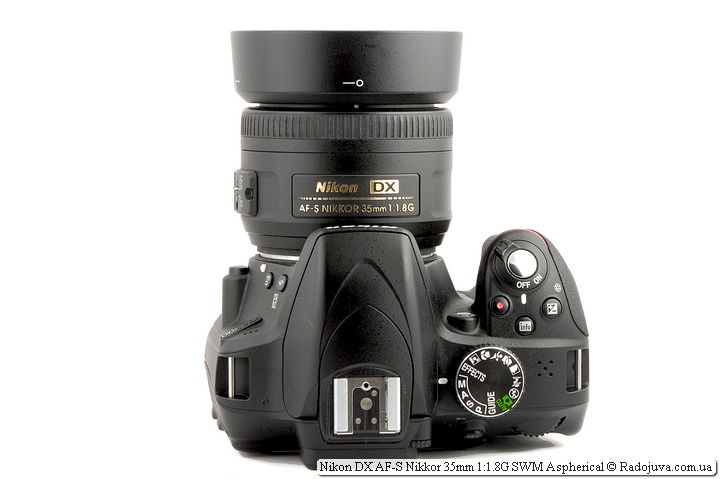
Nikon DX AF-S Nikkor 35mm 1: 1.8G SWM Aspherical with Nikon HB-46 lens hood Nikon D3300
Lens features on Nikon FX full-length cameras
Interesting: the lens has a good margin of performance, it can work with grief in half and on full-size Nikon FX cameras (for which it is not designed to work) Here is the link on mine sample photos on Nikkor AF-S 35mm f / 1.8G DX and full-format camera in FX image area mode.
Image quality
Good picture quality is obtained due to use aspherical element in the optical circuit of the lens. On foreign sites they write that the lens uses plastic inserts for a hybrid aspherical element, I did not find detailed information about this. Chromatic aberrations (HA) are highly visible until F / 3.2. The purple halo (Purple fringing), which is difficult to remove even when shooting in RAW and post-processing. To catch such a halo, you need to try. The purple halo border is the only major drawback of this lens.
In general, the lens has “cream” bokeh. Don't expect the lens at f / 1.8 to blur the background too much when photographing portraits. For portraits, any half a ruble (50mm fixed lens). I recommend reading my article about how to take pictures with a blurred background.
Distortion 35 mm still remained and quite a bit makes its own negative adjustments.
Vinienting imperceptibly at any aperture. Natural color renderingeasily fixed by setting white balance in the camera. Lens very sharp at any aperture.
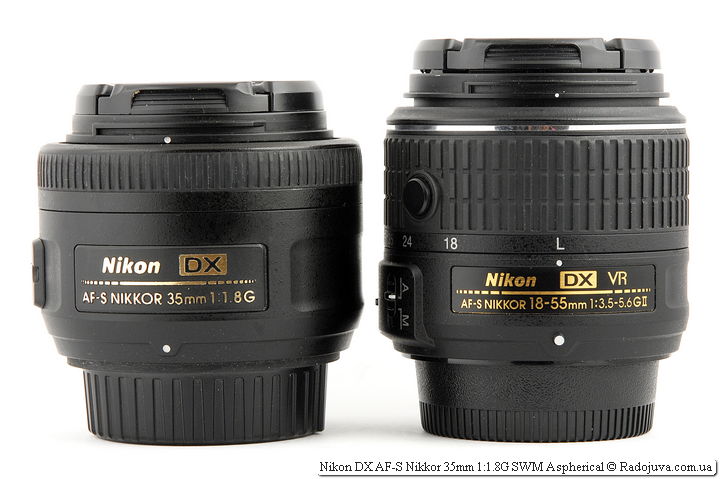
Dimensions Nikon DX AF-S Nikkor 35mm 1: 1.8G SWM Aspherical and Whale Lens Nikon 18-55mm 1: 3.5-5.6GII VR II AF-S DX Nikkor
Alternatives
If you are looking for a lens of this class, then The following lenses can serve as alternatives at a similar cost or functionality:
- Sigma 30mm F1.4 DC HSM ART
- Sigma 30mm 1: 1.4 EX DC HSM
- Nikon DX AF-S Micro Nikkor 40mm 1: 2.8G SWM
- Yongnuo 35mm 1: 2 (YN35mm F2N, for Nikon cameras)
My experience:
The 35 mm fix, even on the DX matrix, is quite short and not familiar to me, but shooting with this lens is a fairy tale! Ergonomics and functionality on top. All those who want to upgrade their whale lens, I recommend this particular Nikkor AF-S 35mm f / 1.8G DX.
More examples of photos on the Nikon DX AF-S Nikkor 35mm 1: 1.8G SWM Aspherical with source RAW files can be found in the review Nikon D3300.
Lens prices
The real prices for Nikon DX AF-S Nikkor 35mm 1: 1.8G SWM Aspherical can be found in stores and catalogs:
Comments on this post do not require registration. Anyone can leave a comment. Many different photographic equipment can be found on AliExpress.
It is often difficult to choose between Nikon DX AF-S Nikkor 35mm 1: 1.8G SWM Aspherical and Nikon AF-S Nikkor 50mm 1: 1.8G SWM Aspherical, thoughts about this find here.
I am also often asked how this lens differs from Nikon AF Nikkor 35mm 1: 2D, the difference is described in detail here.
An accurate list of all Nikon DX Nikkor lenses
- 10.5 mm/ 2.8G AF Fisheye [gold ring]
- 35 mm/1.8G AF-S
- 40 mm/2.8G AF-S Microphone
- 85 mm/3.5G AF-S VR Microphone
- 10-20 mm/4.5-5.6G AF-P VR
- 10-24 mm/3.5-4.5G AF-S
- 12-24 mm/4G AF-S [gold ring]
- 16-80 mm/ 2.8-4IN AF S VR [gold ring]
- 16-85 mm/3.5-5.6G AF-S VR
- 17-55 mm/2.8G AF-S [gold ring]
- 18-55 mm/3.5-5.6G AF-S [black / silver]
- 18-55 mm/3.5-5.6GII AF-S [black / silver]
- 18-55 mm/3.5-5.6G AF-S VR
- 18-55 mm/3.5-5.6GII AF-S VR
- 18-55 mm/3.5-5.6G AF-P
- 18-55 mm/3.5-5.6G AF-P VR
- 18-70 mm/3.5-4.5G AF-S
- 18-105 mm/3.5-5.6G AF-S VR [Thailand / China]
- 18-135 mm/3.5-5.6G AF-S
- 18-140 mm/3.5-5.6G AF-S VR [Thailand / China]
- 18-200 mm/3.5-5.6G AF-S VR [Japan / China]
- 18-200 mm/3.5-5.6GII AF-S VR
- 18-300 mm/3.5-5.6G VR
- 18-300 mm/3.5-6.3G VR
- 55-200 mm/4-5.6G AF-S [black / silver, Japan / China]
- 55-200 mm/4-5.6G AF-S VR
- 55-200 mm/4-5.6GII ED VR
- 55-300 mm/4.5-5.6G AF-S VR
- 70-300 mm/4.5-6.3G AF-P
- 70-300 mm/4.5-6.3G AF-P VR
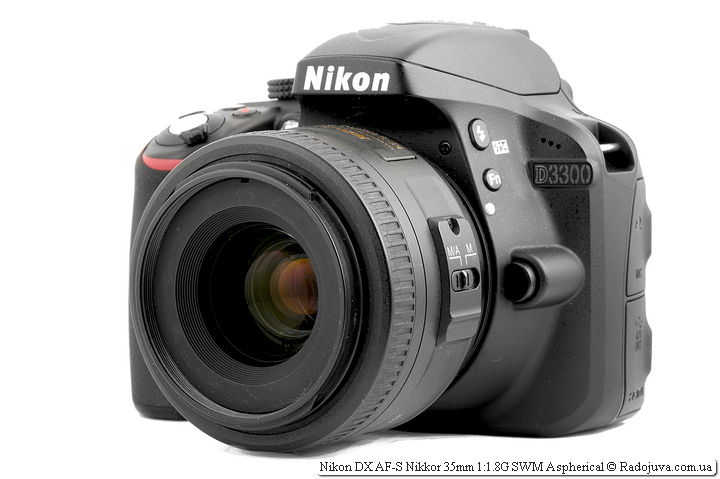
Nikon DX AF-S Nikkor 35mm 1: 1.8G SWM Aspherical on Camera Nikon D3300
Results
Nikon DX AF-S Nikkor 35mm 1: 1.8G SWM Aspherical is an excellent standard high-aperture prime lens for cropped Nikon DX cameras. The lens has excellent sharpness and compactness, works on all digital SLRs Nikon. The lens has only one serious drawback - strong purple halos on the contrasting details of the image.
If you have any question about this lens, feel free to ask it in the comments and they’ll answer for sure. Also, in comments write your reviews, impressions, opinions and ratings of this lens.
UPDATE 1: A cheap similar lens went on sale in 2016 - Yongnuo 35mm 1: 2 (YN35mm F2N, for Nikon cameras, review at this link).
UPDATE 2: in 2020, a large overview of the premium lens appeared on Radozhiv Sigma 30mm 1: 1.4 DC A (Art).
Material prepared Arkady Shapoval. Training/Consultations | Youtube | Facebook | Instagram | Twitter | Telegram

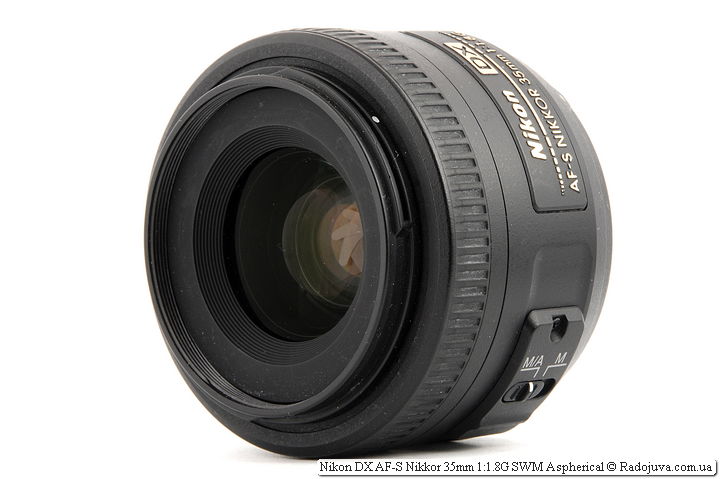




















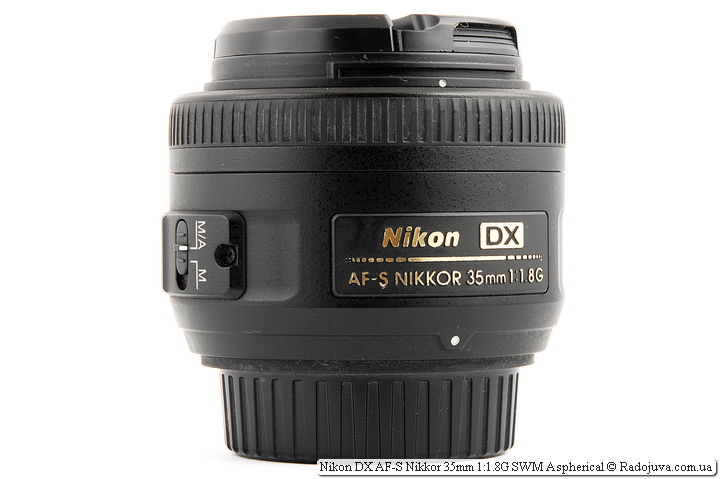
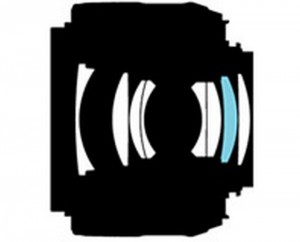
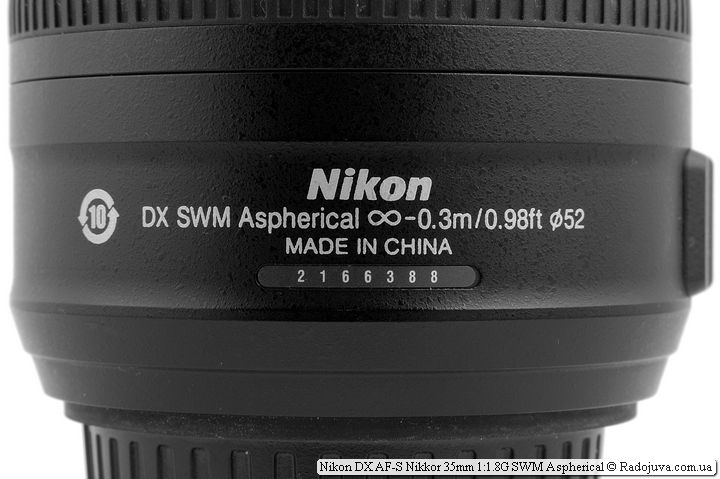
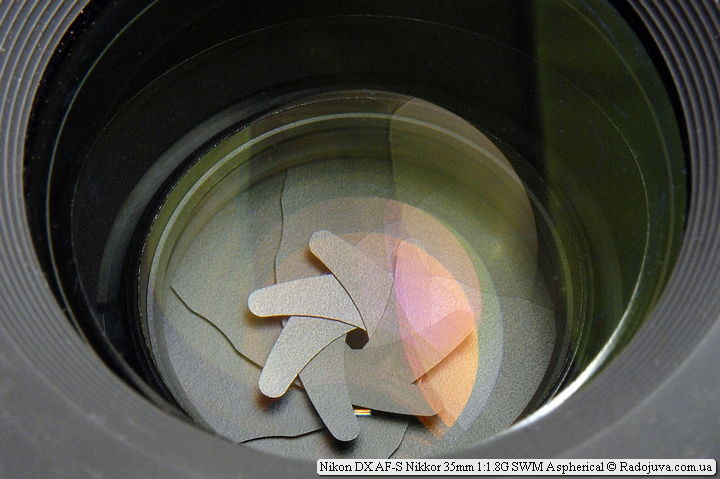















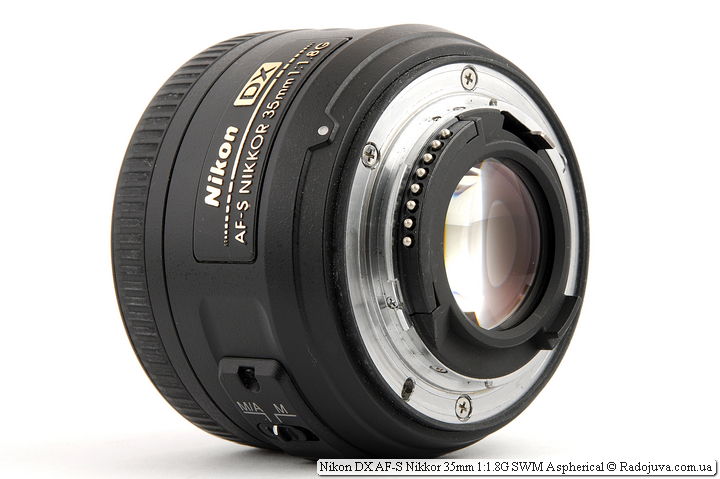
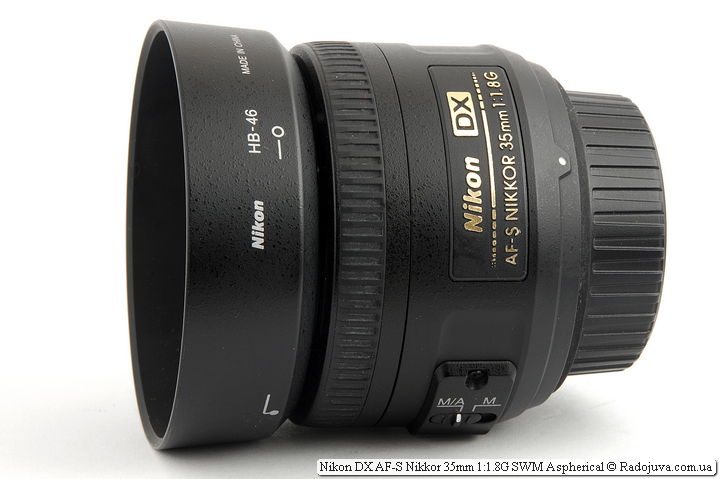
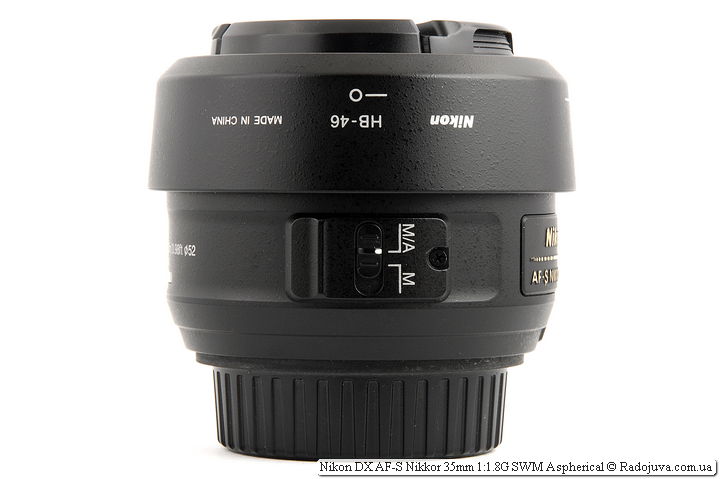































Hello,
I use this lens, I like it.
The question is, is it possible to shoot a reportage shoot with him? In particular, a dance competition or, for example, a school ball?
Of course, you can shoot, no one forbids. The only question is convenience. It all depends on how and where to do it.
Hi Arkady. Have a look at the AF-S NIKKOR 35MM F / 1.8G ED lens?
I support). I searched for it myself, did not find it. And here are the best reviews.
It’s enough, just cover the diaphragm so that the depth of field is bigger, and you will finally crop on the computer.
Here, the same story with B.F., But there was an assumption of insufficient tenacity of autofocus, the maximum open aperture and the rapid movement of people in the frame. I have not tested it yet.
And really purple edging on too contrasting borders of objects is removed by adjusting the corresponding color slider in F.Sh. The rest of the lens is cool, at least for the money that was given for it ...
For an upgrade of D90 whale lenses, which lens is preferable in your opinion to a fifty dx or this
There is no such 50 dx.
Watching for what? As a replacement, better than 35, as an add., Such as for portraits, then 50
I'm sorry I meant fifty kopecks FX
Take 50
... I was not so lucky, and my copy turned out to be very noisy (whistling, rubbing, almost cracking: - / ..), but only in automatic focus mode; on the manual quiet ..
And it also gives out double focusing points .. I thought I could see double in my eyes, no - in the lens: (((every other time: - / write that problems with the drive itself, requires disassembly / repair ...: ((((what will they say here about this) , maybe someone like this happened? .. a little desperate mood, have not had to treat lenses yet, the prospect of this seems gloomy ..: - /
Please tell me, how will Tamron 17-50 / 2.8 or Sigma 17-50 / 2.8 be compared to this lens?
In principle, I do not need such an open aperture 1.8, but about the quality and sharpness of 35mm, the nikkor is well-read and heard. But still, as a universal lens, I would probably like the zoom that I mentioned above. I think 35mm. will it be much better in sharpness and pattern than a tamron or sigma zoom, or will there not be such a big advantage?
Take zoom as a versatile lens, of course. Such was the case: I bought a Nikon 40 / 2,8, started comparing it with 18-55, not “wow,” but noticed a difference in sharpness and clarity. Then I took the first tamron 28-75 / 2,8, again the test with 40 / 2,8 - no matter how I compared the photo of the object (tamron at 40mm and the same diaphragms), I did not see the advantages of 40 / 2,8, at least obvious. And 35 / 1,8 (there is one) will not be sharper than 40 / 2,8. And the drawing of 35 and Tamron is approximately similar.
1. Thanks to Arkady for the site. Thanks to Arkady and everyone for the answers
2. Given: Nikon 3100 18-105. Does it make sense to buy this lens for landscapes - dawn / sunset 50% day 20% night 20% people 10%. Is he good at night? Stars, thunderstorms, clouds? I understand that the frame size will be less than 18. Will the pictures be sharper than with a whale? Thoughts: if you press down the aperture by 35mm, the sharpness increases, due to aperture speed the exposure will decrease. The evening is easier to shoot, less shake. Compared to the whale. The whale is some kind of middle one, even there is not enough in it. Why this particular price, something more expensive is not yet considered
35 even open will be sharper and generally more pleasant than this zoom even at f / 8. He, in fact, has only one really weak point - purple halos around very large differences in brightness such as branches against the background of an overcast sky.
But for standard landscapes it is very narrow.
On the other hand, something wider for a crop with comparable quality and for reasonable money is still not available. The new 10-20 AF-P is good and inexpensive, but it won't start at 3100.
Thanks! Narrow, yes (((it’s not clear where to move further. It used to be easier, change 8 and go!
Well, not so narrow, I shoot a lot for them. And then move in the direction of used, once the price. Old widths a la Sigma 10-20, Tokina 12-24, Nikon 10-24 just fit in with the price like the new 35 DX. There is still a chic fisheye Nikkor 10.5, but it's not for everybody.
Here, here's another thing. In the afternoon I’ll deal with a whale more or less, but in the evening and at night I don’t like it at all. So rather this lens is for harsh conditions
and in the evening what kind of photograph? if only a completely night city and tripod
Clouds, thunderstorms, astro, fireworks, few people in the background, travel photos. Yes tripod
But what, take two steps back is not fate?
Where are two steps? So I want to fit a frame of a mountain, a river and a forest, and with fifty dollars (which is 35 on the crop) - only one thing will allow. Even if I go at least 20, at least 200 steps, which is not always possible at all, absolutely nothing will change: either a river, or a mountain, or a forest.
the big journey begins with the first step)
It is not always possible to take these two steps.
if you can’t take 2 steps back, you need to turn around and take 2 steps forward!
I use this lens on the D7200. Satisfied. For this money it is a sin to complain.
Good afternoon. Nikon D7200 was purchased with zoom (Tamron 17-55, f2,8). After 2 years of use (I'm an amateur, not a pro) I came to the conclusion that I need to buy at least one good fix. I can take nikon 35, f1,8, which is discussed in this thread, or I can take nikon 35, f1,4. I have a question for Knowledgeable People: "Will the picture be better (?) From a more expensive glass, if used on D7200, or I won't notice the difference"? For more specificity, I will clarify that we are comparing with one aperture f1,8. I understand that the 2nd glass is for FF, but I'm interested in the final result - this is the picture itself in RAW. We are not discussing the rationality and logic of buying expensive glass for an amateur camera. I am not interested in theoretical opinion, but in the answers of people who have practically tested it. Thanks in advance to everyone who answers, I will be grateful for any information.
Of course, the Nikon 35, f1,4 will be sharper at 1,8 aperture. Further, the difference will decrease. But a very important question: what will you do with the photos? If you print 20x30, then yes, the difference will be noticeable. And when viewed on a monitor, even a large one, you will not see the difference.
Hello, I'm a photographer. currently switched from nikon d3100 to nikon d300. Now I have one lens fixed 50 mm 1,8G. I work mainly in studios and landscapes. Please advise me to take 35 mm or still zoom on the type 16-85 mm. I will be very grateful for the advice!
For landscapes, the D3100 was more interesting, IMHO. And for the studio, and in general - it depends more on the straightness of the hands and the right light. If you were shooting sports in Jpeg, then I would understand your transition.
For landscapes, 35 will not be universal. It is not always possible to come and go, but here is a fix, and with 12MP you can't cut a lot. In the studio - it depends on what you shoot, and in general in the studio 90% can generally be filmed with a whale, again we come to the non-versatility of 35mm. For example, you normally won't shoot a face portrait, neither at 35, nor at 50, but at 85 it is already possible, although 135 will be better.
PS If you call yourself a photographer, you should know all these things. If you do not know, read the articles of Arkady, here on Radozhiv, almost all issues are covered, including the choice of optics.
PS2 I don't understand the transition to the D300 now. Only because of prof. management? I dreamed about the D300 when I bought the first budget CZK, and when I bought the second I realized that the new device is generally better in many respects than the old man. My path as an amateur photographer looks like this ≈1995-> 2001-> 2007-> 2011-> 2015-> 2019 'Kiev-4 ′ ->' Zenith '->' Ultrazoom Panasonic FZ50 ′ -> Nikon D5100-> D7100-> D750
I switched because such an opportunity turned up and the d300 is more interesting to me in management, and of course it looks more solid than the d3100. I don't have a universal lens now, so I think it might be worth buying fixes and since I already have 50 mm (but for a studio with it only a portrait is not enough for me), I think about 35 mm as a universal. In any case, plans to buy both 16-85 mm and 35mm, I can't decide what to buy is more practical first…. I'm a photographer, yes, but not with a capital letter I ask such questions here ...))))
16-85 mm more interesting in terms of versatility.
So they’re switching over not only because of the photo.
I’d take pictures now and now at d90, he always suited me.
But the D300 is full-hd, and the further you go, the more monitors you can feel the difference from 1280. Plus, in the D90 autofocus does not work in the video, that is, it will not be possible to shoot video fully. The urge to work with video has always been, so when I choose a camera, I look in this direction. At the same time, parting with an old friend is not at all necessary)
The zoom is less fast. If you're not constantly shooting indoors without a flash, and versatility is more important, Zoom is better. I just have from the very beginning two fixes for two carcasses, 35 and 50 on D90, that is, the angle is slightly larger. But I like this option. I'm a beginner myself, so I won't advise anything. But I will say that my version completely suits me, I did not think about zoom.
If portraits are of lesser interest, then 85 MB is superfluous. The artistic approach to the same landscapes can be different. It's just that some landscapes come out on a wide angle, others on a portrait portrait. With an emphasis on detail. I went on vacation this year with one 85mm, and it turned out to be beautifully photographed the architecture (though - having driven off a respectful distance) and the fields-hills.
Although, it seems to me, it is difficult to resist the desire to shoot a good facial portrait when the model is good.
IMHO 12-24 + 35 / 50. At the very tamron 17-50 + 35g.
I liked the photo - a stork on the background of the moon. Nikon d3200> 35 mm f / 1/8. What settings should I set - or are these flamingos standing still for a long time?https://ibb.co/jZdFjhJ
Judging by the brightness of the Moon, there were no 'special' settings. I would venture to suggest that it would have been something like f / 4 1/100 ISO 400. At least - I would have put it about for such a scene.
There also trees from the shadows are thoroughly elongated, and the moon is crushed. Usually a full bright moon shines so that if you shoot it with the surrounding landscape, or the moon becomes a white circle with a halo around it, or details appear on it, and all branches go into darkness. So half the photo is processing.
Thanks! Your site is the best!
I recently purchased this glass, in comfy, in Lviv. And, one might say, he was specially following him from Warsaw) I ordered two lenses from the seller and the next day I tested them on the spot and chose one and bought one. He tested it on the d7000 all day. The lens is VERY sharp with an open, nimble, silent, not a bad boke. It seemed to me because of the UV filter, glare can sometimes appear, or the lens itself catches hares. Overall very satisfied. I used the same 35ku a couple of years ago, but it was very unstable in terms of focus. So I advise you to choose from a pair of pieces. I will add that very suitable portraits can be shot on this focal crop. It is clear that with an increase in focal length portraits will be even better) In general, this fix is a must-have for crop. Well or 50 mm
Acquired as a standard fast.
BUT….
Really works from a diaphragm of 3-3,5. more open halos spoil everything.
So it turns out the zoom is fixed at 35mm.
Less sharp even when compared to the AF-P 18-55 VR /
At short distances, the focus point coincides with the start of the depth of field.
have to manually shift slightly.
Even taking into account the crop is a little short as a portrait
Alexander, we never saw your sharp photos from 18-55 (well, except for cats at close range). Maybe it's not about the lens? Yes, he suffers from halos, but not really that much. And it corrects quickly during development. And of course this is not a portrait lens, this is the standard focal length for a crop. 18-55 in this case is more suitable for portraits. And at the expense of short distances - go out into the street, let the cats rest. This is a great lens.
What kind of halos are these? His spherical aberration is well fixed.
Chromatic on open. Many scold him for this, but on the “excellent” Zonar 105 / 2.5 they are much stronger. When I saw it for the first time, I regretted having bought the lens. But when I started to use it, it turned out that they do not interfere when used as a portrait. And if they climb somewhere, then they go beyond the borders of the IPG and rule without consequences. With 35, too, there are no special problems, the native developer does everything himself, in DXO just move the slider.
A friging. So almost all fast lenses have it)
Great lens
Recommend a good protective filter for this lens.
if cheap - any branded from the store, and not with Ali (hoya, kenko, marumi), and not flama, dicom
rekam did not try
Hello.
What to buy in the appendage to this lens for filming in the studio and outdoors?
50 1.8D? 85 1.8D? 80 1.4 - I won't pull it financially, even 85 is already somehow expensive for 250 used bucks.
D300S Camera
I advise 85 1.8G, if it is expensive, then 85 1.8D
What is G, what is D at almost the same price. Thanks I will think.
Have you encountered a Kaili Kelda 85mm f / 1.8 lens?
Choosing between this and the sigma 17-50, for the nikon d7500, which advise lens? I want to master astrophotography. Which one is better?
35 1.8 is better for this business
Thank you very much. I will take 35 1.8
Good evening!
Please tell me, I have a Nikon D90 camera with a Nikon 18-105mm 1: 3.5-5.6G ED whale lens, I want to buy a Nikon DX AF-S Nikkor 35mm 1: 1.8G lens.
Which of these lenses has better color reproduction.
Thanks a lot in advance.
You won’t feel the difference
What kind of beast is Zhongyi Creator 35mm f / 2? Who was holding it? I correctly understood that the aperture from the camera is not controlled in any way, but only by hands?
Maybe there are some decent inexpensive manual import lenses for Nikon F mount, no more expensive than Nikon DX AF-S Nikkor 35mm 1: 1.8G SWM Aspherical? Or maybe even made of glass and metal?
Any old fifty dollars just right. 35-tki is usually a little more expensive than fifty dollars. By itself, 50mm on a crop fits a portrait better than 35mm.
I bought with my hands 50 mm 1.8 D, the picture is not bad, but extremely disappointed with the design. Backlash, the picture jumps in the viewfinder, a small angle of rotation when manually adjusting for sharpness, the impression of a lack of lubrication. I want something inexpensive without these shortcomings, but not the World.
https://zyoptics.net/product/mitakon-creator-35mm-f-2/
The Mitakon Zhongyi Creator 35mm f / 2 lens is a classic wide-angle lens featuring a bright f / 2 maximum aperture, manual focusing and an all-metal lens barrel design. Designed for the full-frame and APS-C formats of Canon EF, Pentax K, Sony A, FX, and Nikon F DX-format cameras, this lens consists of seven elements in five groups, which helps minimize distortion and maintain sharpness throughout the frame. Aperture Range The maximum f / 2 aperture is also combined with a nine-blade rounded aperture for smooth bokeh using shallow depth of field techniques.
Will there be a review on the Nikon 35mm AF-S F / 1.8 G ED?
I'm looking forward to it too)
I recently got this used lens after reading reviews. In general, the lens is good - in terms of the picture, in terms of focal length it is very convenient, f / 1.8 is really working, provided it is in focus. But there is one big BUT! I came across a defective specimen - a terrible front focus at close range. I made adjustments in the carcass (d300s) at about +15, it seemed to start hitting the target, but at the same time, back focus is obtained at a long distance. When checking for front / back focus on a target at a minimum distance (camera at 45 degrees, without corrections), the lens gives out front focus, and it is not uniform over the frame field - less on the left, more on the right, i.e. the horizontal axis of the lens seems to be 5-10 degrees rotated relative to the center. If you change the angle of the camera in relation to the target to a sharper one with the same MDF, then the lens goes into back focus.
After that I checked the camera with another lens - 50 / 1.8d, everything is fine, it hits the target. So I don’t sin on the carcass, because before that problems did not arise for 7 years.
A reasonable question arises - is it either the crooked-handed Chinese who collect it so that they have such a spread in quality, or my lens was dropped, or is there any other explanation for this?
boo. - that's the whole answer. What happened to him, what he saw, no one will tell the truth
Tell me what normal UV filter to buy for this lens, I have Kenko, I’ve bought it in a decent store, the seller advised it as a result, it costs about a year to catch hares decently, I reflect in it almost like in a mirror and yesterday I saw large dots on it sort of like enlightenment slazit. Can you advise which filter to pay attention to and in which online store is less likely to run into frank bullshit, Rosette for example a normal store?
I had a lot of different Kenko filters, but you didn't have one like you - this is typical for very cheap Flama filters. Check out Hoya filters. There is no point in buying more expensive types B + W or Rodenstock for this lens.
I bought such a back-focus lens through the viewfinder (5200), through the live view the norms get into focus. And I noticed this later, at first there seemed to be norms. Now you have to shoot through live view
Where is Nikon AF-S 35mm F1.8 G ED Nikkor?
On the shelves in stores, distributors' warehouses, service centers, and in the hands of users.